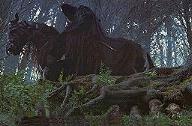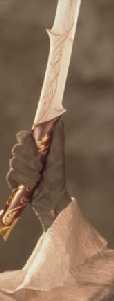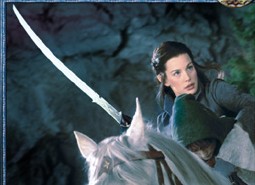|
HOME
The power of the Nazgul can be seen in the way that nature retreats before them. The surrounding environment is pushed away from them, it warps and darkens in retreat. The darkness under the cowl of the wraith is imperialistic, it draws out the life force of the surrounding greenery, darkening the trees and blackening the air. We have seen this in the shire:

So in the image of the Nazgul in retreat at the Bruinen we see nature reclaiming supremacy. The element of water has such momentum that it can fill the void in nature created by the wraiths and deny them domination. The domination of nature by the wraiths is most successful on land, the trees cannot fight back in the shire, but the element of water (as opposed to earth) has the combative power to quickly overwhelm them.

Above we see how the water is an element that carries light. The onrush of the water brings a flood of light to the Nazgul, something they cannot tolerate. The invasion of the white light into their background makes each rider seem isolated and helpless. The power of water is to deny the ground of domination by evil. The immune system of nature has reacted and overwhelmed the invaders.
It is worth spending a moment reminding ourselves about the spiritual spectrum in Lord of the Rings. Black is at one end (shadow, evil) then it flows to grey (spirit in love with life on earth) and on into white (pure spirit). The spectrum looks like this:
The way to defeat the Nazgul is to bear down on them with light. Fire will keep them at bay but light will bring them down. The white light of spiritual power which is at the opposite end of the spiritual spectrum to the Nazgul is intolerable to them. In Fellowship water conveys light and is the agent of the white light of the spiritual spectrum. Tears also convey light. Arwen sheds a tear for Frodo on the banks of the Bruinen again referring back to the power of light. From the eye of Sauron gushes only fire to burn. From the eyes of heros and elves come tears of light.

Arwen has invoked the elemental power of water. Arwen uses a feminine power to win through. Arwen does not fight the Nazgul with fire, a male attribute, as Strider does but evokes the feminine element of water. Arwen here is raising her sword evoking the feminine image of the goddess who can command the normally nurturing power of nature into a terrible force. At this moment she is both Kali and the Lady of the Lake. She both commands the elements and wields the sword.

The sword itself is engraved with extended and swirling spirals. As the light picks up the spirals we are reminded that water is a carrier of light. The spiral also refers to the spiralling currents of the water and its momentum. The spiral also enhances the spiritual quality of the water/light, being a symbol of a higher element. This sword is a powerful statement. It tells us as much about Arwen's power as Gandalf's staff informs about the grey wizard. The sword is held aloft as the water rushes in. The curve of the scimitar echos the onrush of water round the hidden bend of the river.

Arwen herself is still and composed but within her stillness she can command the waters as a mighty army. She uses the principle of attraction to pull the waters over the wraiths whilst offering her vulnerability as bait. Arwen's twin feminine powers seal the trap. Her white steed and the silver light of the sword are a mirror of the onrushing horses manifesting in the water. The light on the sword further reinforces the magical aspect here. Arwen does not use her weapon to fight as a man would do but holds it up as a symbol of her command over the water.

|